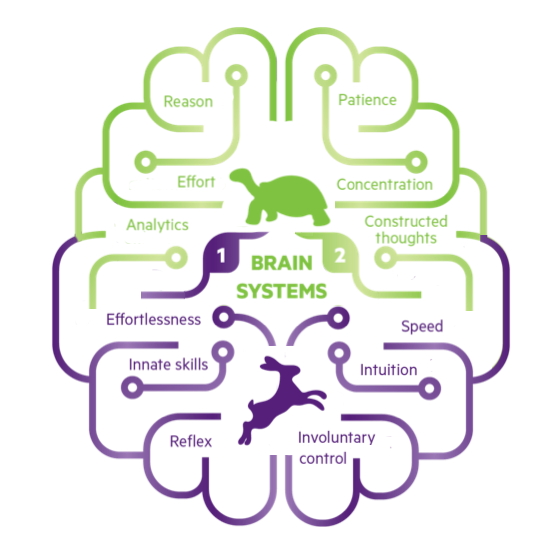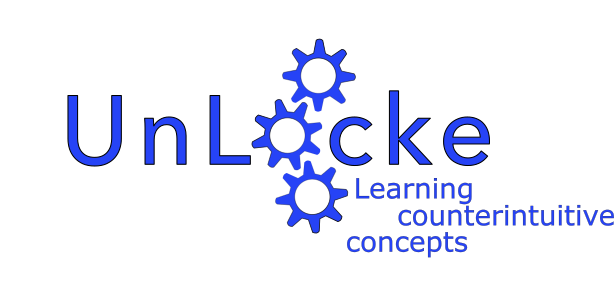Previous research suggests that two distinct ways of reasoning co-exist and compete with each other in the brain [1] [2] [3]. One way is based on a system that is evolutionarily old, fast, automatic and parallel, and enables us to make decisions intuitively and very quickly in situations that are familiar (the heuristic-based System 1). The other way is based on a system that operates more slowly, is sequential, based on rules, and enables us to engage in abstract logical reasoning and hypothetical thinking (the analytic System 2) (see Figure 1). Importantly, a key aspect of this organisation of thinking is that the analytic system is able to inhibit (suppress) and override the heuristic system when needed so that individuals can think things through and successfully carry out logical tasks instead of giving an automatic, immediate, incorrect response [1] [2].

Image from http://bigarrowgroup.com/tortoise-hare- marketing/
Brain imaging research in adults has shown that when people are engaging System 2 and inhibiting System 1 there is increasing activation in the prefrontal cortex, the most forward part of the brain, just behind the forehead. Increased activation means that this part of the brain is working harder processing information. The prefrontal cortex allows us to control our behaviour, attention and thoughts in order to achieve our goals. Importantly, scientists have found that after a brief training session, individuals asked to solve a logical problem for which they had initially given an intuitive, incorrect answer to, could now switch to engaging the analytic System 2 and provide the correct answer. Moreover this was associated with a shift in brain activation from the back of the brain to the prefrontal cortex [3]
The UnLocke project is based on this premise, while focusing on the context of science and maths education in primary school. Our aim is to implement a training intervention, in schools, that will encourage children to engage their more analytic System 2 when solving maths and science problems.
Conceptual change is the idea that when we are provided with new evidence we update our understanding accordingly. The traditional view of conceptual change was that new theories replaced old theories. For example, this suggested that once a child had learned that the Earth rotates around the Sun, their previous theory (based on the experience of seeing the Sun move in the sky) that the Sun rotated around the Earth, was completely overwritten. Recent evidence in adults instead suggests that, in fact, these old, incorrect theories, remain stored in our brain in the face of new evidence, and that inhibitory control is needed to suppress the old, incorrect theories [4]. The naïve, incorrect theory is more familiar and intuitive, and corresponds to System 1 responses. It needs to be suppressed and the correct new theory needs to be retrieved and used by System 2 to give a correct response.
Within the context of education, misconceptions are frequently observed. They arise when children are asked to reason about counterintuitive concepts and they do not manage to inhibit or suppress, their naïve theories, old strategies, or misleading perceptual cues (e.g. that the Sun appears to move in the sky). Importantly, children and adolescents are often taught more and more complex theories as their school years progress, with the expectation that they will replace previously learned simplified versions of the theories with the more complex ones. For example, children initially learn positive integer numbers, in sequence (e.g. 1, 2, 3, 4, 5 etc.). They are also taught that 5 is larger than 1. Children practice this until they are very fast at saying that 5 is larger than 1. Later, children are taught about negative numbers, where -5 is smaller than -1. Children often make the mistake of saying that -5 is larger than -1, because 5 is larger than 1, and they find it difficult to inhibit this automatic response and consider the new knowledge they have been taught about negative numbers being organised differently than positive number.
Although conceptual change is relevant for a whole range of subjects, misconceptions are particularly common in maths and science. In science education, it can be a real challenge for children to acquire knowledge that goes beyond popular beliefs or perception, while in mathematics children need to go beyond the perceptually obvious solutions to uncover formal logical solutions to a problem[5].
In addition, Science and Maths are domains of key economic importance to the UK. Science, Technology, Engineering and Mathematics (STEM) industries, which contribute over £68 billion a year to the UK economy and account for over a third of UK exports. Despite their importance, there has been little emphasis on interventions that target mathematics and science skills, particularly when compared to the wealth of literature on literacy skills intervention.
There has been extensive research trying to improve children’s cognitive control[6], however these studies have had limited success in terms of showing transfer of improvements to performance in school. It has been argued that it may be critical to train cognitive control within the specific domain of interest, in our case maths and science, in order to show benefits of training [7]. The UnLocke intervention will train children to engage their analytic system 2 and inhibit their automatic system 1 answers using an approach embedded within the science and maths curriculum. The exercises children will do through a computerised game will encourage pupils to inhibit an initial response, in favour of a more delayed and reflective correct response.
- [1] Evans, J. S. B. T. (2003). In two minds: dual-process accounts of reasoning. Trends in Cognitive Science, 7, 454-459.
- [2]Kahneman, D. (2011). Thinking, Fast and Slow. Farrar, Straus and Giroux, New York. Trends in Cognitive Sciences, 7, 454–459.
- [3] Houdé, O., Zago, L., Mellet, E., Moutier, S., Pineau, A., Mazoyer, B., & Tzourio-Mazoyer, N. (2000). Shifting from the perceptual brain to the logical brain: the neural impact of cognitive inhibition training. Journal of Cognitive Neuroscience, 12, 721–728.
- [4] Dunbar, K. N., Fugelsang, J. A., & Stein, C. (2007). Do naive theories ever go away? Using brain and behavior to understand changes in concepts. In M. C. Lovett & P. Shah (Eds.), Thinking with data: 33rd Carnegie sympoisum on cognition (pp. 193–206). Mahwah, NJ: Lawrence Erlbaum
- [5] Stavy, R., & Tirosh, D. (2000). How students (mis-) understand science and mathematics. New York: Teachers College Press.
- [6] Thorell, L. B., Lindqvist, S., Bergman Nutley, S., Bohlin, G., & Klingberg, T. (2009). Training and transfer effects of executive functions in preschool children. Developmental Science, 12, 106–113.
- [7] Diamond, A., & Lee, K. (2011). Interventions shown to aid executive function development in children 4 to 12 years old. Science, 333, 959–964.
A more detailed exposition of the evidence underlying the UnLocke project can be found in:
- Mareschal, D. (2016) The neuroscience of conceptual learning in science and mathematics. Current Opinion in Behavioural Sciences, 10, 14-18. doi:10.1016/j.cobeha.2016.06.001
